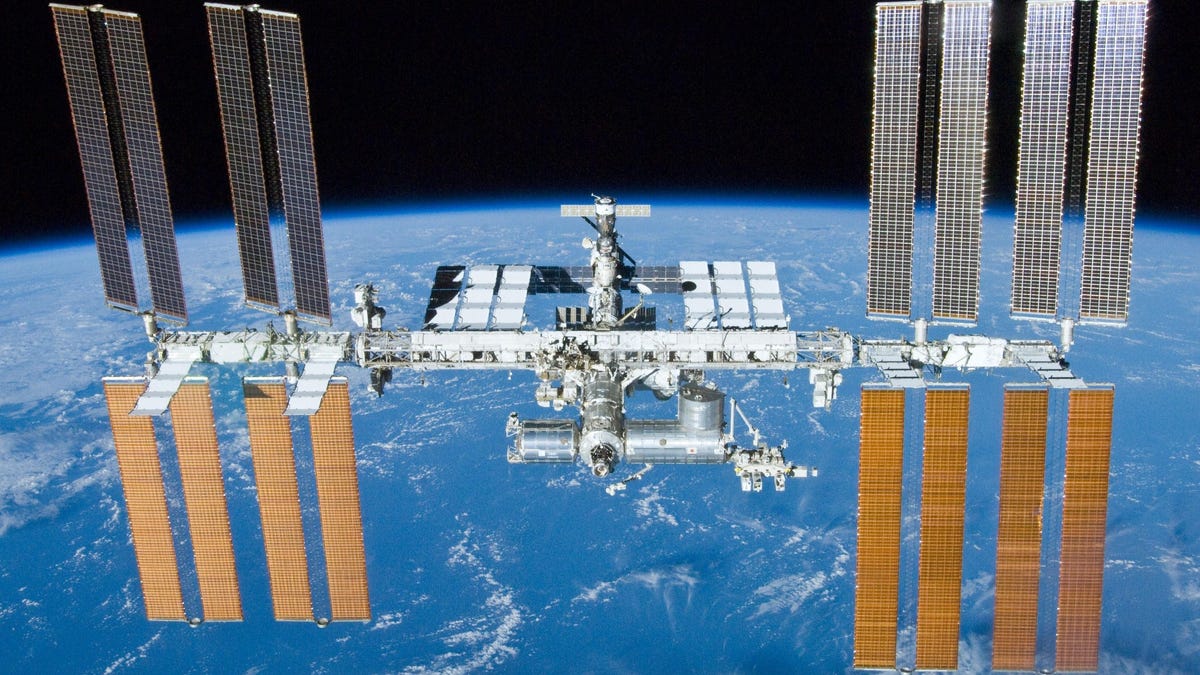UFO or space station? The best way to spot the ISS without a telescope
You don't need any expensive equipment to spot the International Space Station, just this app, an alarm and a quick eye.

The ISS has been in orbit over 7,000 days.
When my husband rushed me onto the back porch claiming we would be able to see the International Space Station passing over our house one night, I didn't exactly believe him. We're far enough out in the country to see stars, but we haven't completely escaped the city's light pollution. Still, I looked up. While I didn't expect to see the ISS taking up half the sky, I couldn't see anything different happening above us.
My husband was looking at his phone, the screen illuminating his face in the outdoor darkness. He told me he'd found an app that could track where the ISS was around the world. After a few moments of silence, he turned and pointed above our roof.
"That's it," he said, as what looked like a bright, rapidly moving star shot over the top of our house.
We watched the ISS speed across the sky and disappear into the clouds. No sooner had we lost sight of the light, my husband told me it was already over New York. That's some hustle.
Space travel has been making headlines this year. This past July marked the 50th anniversary of the Apollo 11 mission to the moon. Just before the anniversary, NASA announced plans for the first all-female spacewalk in history but later nixed it due to a suit-sizing issue. The first space crime was even said to have been committed by NASA astronaut Anne McClain, who was accused of identity theft (she denied the allegations).
The ISS, about the size of a five-bedroom house, serves as a laboratory in space while housing astronauts. The first piece of the Station launched in 1998 and has been constructed by astronauts in its entirety since human arrival in 2000. While orbiting the Earth, astronauts perform unique research, developing plans for the future of space exploration and keeping a consistent human presence in space. Space tourism for the wealthy could also become a possibility in the near future.
While the ISS has been in orbit over 7,000 days, it's captured some truly stunning images as it travels around the Earth.
If you want to keep up with the ISS's location around the world, you can check out NASA's Spot the Station feature on its website or download the NASA app. For more focused space station tracking, you can download the ISS Detector app for any phone, which its developers claim is the most-used satellite tracking app. Here's how it works.
How do I download the ISS Detector app?
The app works for iOS and Android. Use those links or search for ISS Detector in the Apple App Store and ISS Detector: See the Space Station in the Google Play Store.
What permissions does the app need?
The ISS Detector asks for access to your location. This is so it can tell you when the station will be over your area.
The ISS Detector app shows a wide range of data to help you keep up with the space station.
How does the app work?
Once you plug in your location, the app can tell you how often you can expect to see the ISS in the sky. For example, residents of Louisville, Kentucky will typically be able to see the ISS between about 7:57 p.m. and 9:37 p.m. each night for about 30 seconds to a minute and a half. A fleeting window, right? That's because the ISS is traveling at about 17,500 miles per hour.
I found the display was best viewed on a tablet versus a smartphone. The app displays lots of numerical information on a dashboard, and it's easier to digest if it's spread out. The ISS Detector will tell you the upcoming sightings for the next 10 days, potential weather conditions, elevations, latitude and longitude, direction, the current location of the ISS is and more.
The app also keeps track of how long until the ISS will pass over your location and how long it'll be visible. On average, it looks like the ISS is visible in a given area one to two times per day over the course of a week. Whether it's day or night depends on your geographical location.
You can also set up a notification so you don't miss the sighting. Just tap the alarm bell in the corner.
What else can I do on the app until the ISS comes back around?
Set up a notification for the next sighting, have a snack and go to sleep. If the ISS just flew over, you won't see it again until the next day. While you're waiting for the ISS to pass over your area, you can keep tabs on where it is around the world for free.
If you're a space enthusiast and don't mind spending a few bucks, the app has a few extensions that enhance the experience. If you watch an ad, you can also get the extensions free for five days.
- Comet and Planets Extension: Includes night mode, track the moon and its phases, comets and planets for $1.49.
- Amateur Radio Satellites: Includes ham radio satellites, weather satellites and night mode for $1.49.
- Famous Objects Extension: Lets you see objects in orbit like Starlink, X-37B, Vanguard and more for $1.49.
- Combo Package: Includes all the extensions for $2.99.
If you're interested in space news read the latest from CNET:

